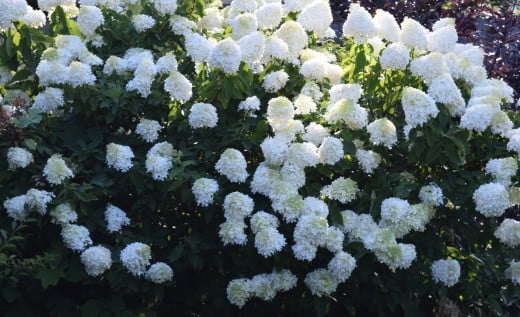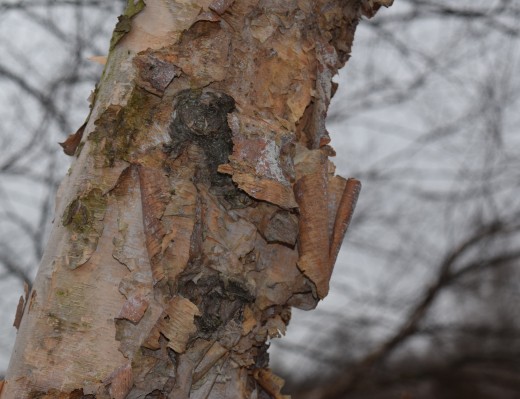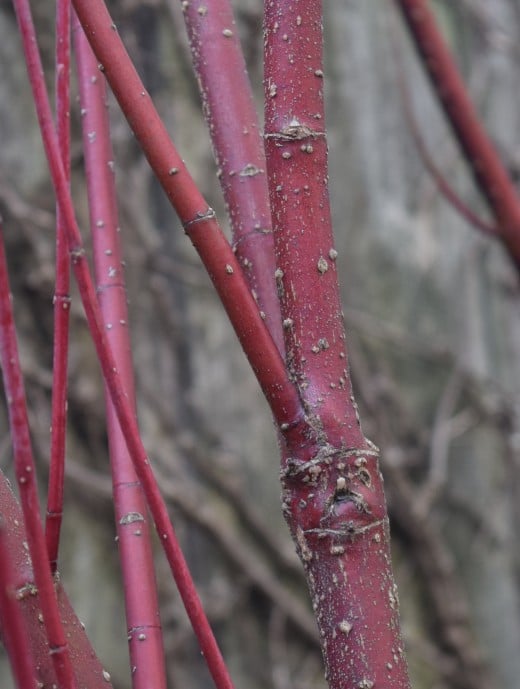Bushes - The Beautiful Workhorses and Four Reasons to Plant Some

Workhorses of the yard. That’s how some describe bushes or shrubs. Often they're planted to solve a problem. But more than being hard working, it’s a joy when your eyes discover their flowers, colorful leaves and shapes. Bushes serve a purpose and make us happy at the same time. Let's see how that happens.
1. Scents, Colorful Leaves and Architectural Trunks
Flowers
- A flower's fragrance is seductive. Shrubs are giant bouquets of fragrant flowers! Different bushes flower spring through fall.
In spring the air smells so sweet. Where’s it coming from you wonder? Follow your nose to find the Korean Spice Bush with its light, spicy-scented flowers.
The strong, sweet blooms of the Lilac bush inspire a hunt to find it.
Yellow easy-care Roses leave a light citrus tang in the air summer through fall.
- Many bushes have flowers that can be cut and brought inside to fill a vase.
Early spring Forsythia cuttings bloom indoors before the shrub blooms outside.
Summer flowering Hydrangeas are great for cutting and bringing indoors. And their flowers change colors as they fade while still on the bush, so there’s a variety of color to cut throughout the season.
Experiment with cuttings from other flowering bushes. A trick to remember: cut stems long enough for the flowers to stay in the vase.

Leaves
- Leaves of shrubs are as colorful as some flowers.
Crimson Barberry leaves begin the spring red or almost purple. Trim them back revealing green leaves underneath. New growth quickly becomes red or almost purple for the summer.
Purple Leaf Sand Cherry leaves are rust-colored in spring, purple in summer.
Burning Bush is green all summer, becoming bright red in the fall, giving it its name.
- Many leaves are aromatic.
Bayberry leaves smell part citrus, part spice if you brush by them or give them a hug.
The sometimes pungent scent of Boxwood lets you know it’s not just a quiet green-all-year bush.
Evergreen needles have their own deep smell too. Stronger in summer, they’re a pleasure to smell in winter – a reminder that bushes are alive even in a mostly leafless winter. Evergreens display their own ornaments: tiny cones or berries for birds to eat. Their name says it all. They’re green all year. The color may fade a little during winter, but count on seeing green every day.

Trunks
With their leaves gone, trunks and branches of deciduous bushes stand out in winter. Shapes revealed look graceful, statuesque and artful. Trunks look smooth, rough, or even peeling.
Red or Yellow Twig Dogwoods change trunk color in winter. Their red or yellow colors really show up in a grey winter landscape.

2. Green and Sustainable
Bushes take care of the earth.
- Clean the air of toxins.
Through the process of photosynthesis, they take in carbon dioxide from the air and release oxygen that we need to breathe.
- Help protect water runoff by bringing rainwater into the ground through their roots.
Many small shade loving plants grow well under the bushes' protective shade. Add a few underneath and increase the amount of rainwater saved from the storm sewer.

- Support wildlife.
Birds find shelter from predators in bushes.Thorns in some bushes may also give protection. Birds eat insects and berries from the bushes. After the leaves are gone, some bushes keep their colorful berries through winter, continuing to feed the birds.
Other animals find shelter and berries in bushes too. Animals like Cottontail rabbits hide, sleep without disturbance, and even build a nest on the ground underneath shrubs.
Butterflies and bees are attracted to nectar in the flowers on bushes. Watch butterflies wander from flower to flower on a Rose of Sharon in bloom. Spice Bush leaves are food for the caterpillars of the Spice Bush Swallowtail butterfly. The Praying Mantis makes an ootheca - a small, hard egg case that overwinters in bushes. Their young emerge in late spring to feed on other insects in the summer garden.

- Help reduce heating/cooling energy use.
On the south side of a house a row of deciduous bushes will keep the building cooler by blocking the hot summer sun with their leaves. In winter when the leaves are gone, the heat from the winter sun hits the side of the building and keeps the building warmer.
Native Plants
- Using bushes native to the area where you live supports local insects and wildlife. They’re usually low maintenance once established because they’re used to the soil, temperatures and rainfall. Go online to find native bushes for your area:
-
Locate your local cooperative extension service and get a list of what is native for your area. Ask if they know of a supplier, or search online “where to buy native bushes.”

3. Define a Space
Bushes define a space.
The width of bushes, once fully grown, can cover a large area. Bushes also grow to varying heights. Some can be as tall as small trees. Use the width and height to your advantage.
- They’re a living fence if you want to mark the border of your yard.
Surround a special area such as a patio or play area with bushes - a sign that this space is reserved for relaxing and the other space is for busy children.
- Like guides, bushes mark the entrance or exit to a path.
Line a pathway with shrubs and follow them to a door, a gate, another area of the yard.
- Bushes make excellent screens for privacy.
For year round screens, Evergreens with their dependable leaves are best.

4. Enhance
- Flowers, leaf color and shape enhance a wall or fence that is behind the bushes.
Many bushes have natural shapes that are architectural such as Harry Lauder’s Walking Stick - a living statue. Bushes can be pruned into all sorts of shapes – geometric, topiary, even animal shapes.
- Use bushes as the backdrop.
Create a scene by placing a statue or yard ornament in front of bushes. Include smaller bushes or flowers in the scene.
- Commemorate an event like a birthday or a person with bushes.
Bushes, if suited to your soil and climate, are also reminders of a place you’ve been. For example, a spring flowering bush that grew in the park where you first met a loved one, bought and planted in your yard, is a memento of that time.
Bushes or shrubs are multi-functional. They solve problems and they look good at the same time. So many reasons to enjoy these beautiful workhorses. Plant a few in your yard!
Location, location, location
The general rule of a "green thumb" is to plant the bush in the right place. It will thrive. Answer these questions to figure out the best place to grow your shrub:
- How much sun does this shrub need?
- How much water and how often does it need to be watered?
- What type of soil does it grow best in?
- How tall and wide will it grow?
Look at the plant's tag, ask a knowledgeable nursery person or check with the local cooperative extension service. Also, there are many books and web sites re: shrubs and their requirements.
How to Prune a Bush
- Basic Shrub Pruning Techniques | Today's Homeowner
Well pruned shrubs and trees are a hallmark of a carefully tended yard or garden....
© 2017 Juli Seyfried








